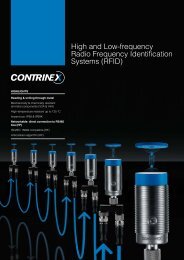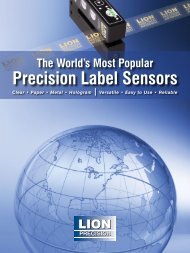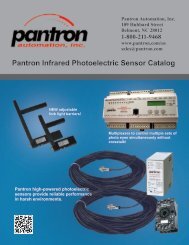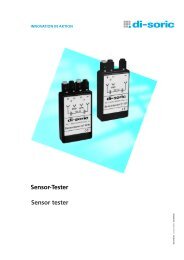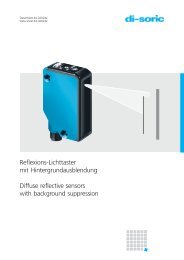Glasfaser-Lichtleitkabel Lichtleitkabel-Verstärker analog, digital ...
Glasfaser-Lichtleitkabel Lichtleitkabel-Verstärker analog, digital ...
Glasfaser-Lichtleitkabel Lichtleitkabel-Verstärker analog, digital ...
You also want an ePaper? Increase the reach of your titles
YUMPU automatically turns print PDFs into web optimized ePapers that Google loves.
Allgemeine Beschreibung General description<br />
di-soric <strong>Lichtleitkabel</strong>-<strong>Verstärker</strong> und <strong>Glasfaser</strong>-<strong>Lichtleitkabel</strong> kommen dort<br />
zur Anwendung, wo die Platzverhältnisse oder die Umgebungsbedingungen<br />
den Einsatz von herkömmlichen optischen Geräten nicht oder nur bedingt<br />
zulassen.<br />
Die Empfindlichkeitseinstellung erfolgt am <strong>Lichtleitkabel</strong>-<strong>Verstärker</strong>, der je<br />
nach verwendetem <strong>Glasfaser</strong>-<strong>Lichtleitkabel</strong> bis zu mehreren Metern vom<br />
eigentlichen Erfassungsort entfernt montiert sein kann.<br />
<strong>Lichtleitkabel</strong>-<strong>Verstärker</strong><br />
Stabiles Gehäuse aus Zinkdruckguss<br />
Einsatz als Reflexions-Lichttaster oder Einweg-Lichtschranke<br />
Tastweiten bis 200 mm, Reichweiten bis 1800 mm<br />
Empfindlichkeits-/Tast-/Reichweiteneinstellung über Mehrgang-<br />
Potentiometer oder Teach-Funktion<br />
Hohe Schaltfrequenz<br />
Hohe Fremdlichtsicherheit durch getaktetes Sendelicht<br />
Grünlichtvarianten zur Glaserkennung<br />
Ausgangsfunktion umschaltbar oder antivalent<br />
Geräte mit Timer-Funktion über Zeitmodul<br />
Kurzschluss- und Verpolungschutz<br />
Kundenspezifische Ausführungen<br />
<strong>Glasfaser</strong>-<strong>Lichtleitkabel</strong><br />
Varianten als Reflexions-Lichttaster oder als Einweg-Lichtschranken<br />
Varianten in:<br />
- Silikon-Metallmantel<br />
- Metallmantel<br />
- PUR-Ausführung<br />
Varianten mit:<br />
- hoher Auflösung<br />
- großen Tast- oder Reichweiten<br />
- biegbaren Tastköpfen<br />
- seitlichem Lichtaustritt<br />
- Silikon-Metallmantel für hohe mechanische Beanspruchung und hohe<br />
Schutzart<br />
- Einsatzmöglichkeit von Vorsatzoptiken<br />
- Faseranordnung rechteckig, koaxial, statistisch gemischt<br />
Hinweise:<br />
1) Alle angegebenen Tast- bzw. Reichweiten sind Durchschnittswerte in<br />
Verbindung mit dem <strong>Lichtleitkabel</strong>-<strong>Verstärker</strong> in Infrarotlicht.<br />
Erforderlichenfalls ist der Empfindlichkeitsbereich mit dem<br />
Grundempfindlichkeits-Potentiometer P2 anzupassen. In Rotlicht<br />
reduzieren sich die angegebenen Tast- und Reichweiten auf ca. 80 %<br />
und in Grünlicht auf ca. 30 %. Die Werte sind ferner abhängig vom<br />
<strong>Lichtleitkabel</strong> sowie vom abzutastenden Objekt (Größe, Form, Oberfläche,<br />
Farbe usw.).<br />
2) Mit Vorsatzoptik und axialem Lichtaustritt (siehe Seite 12). Nur bei<br />
entsprechend langem <strong>Lichtleitkabel</strong> möglich.<br />
2<br />
di-soric fibre optic amplifiers and glass fibre optic cables are used wherever<br />
space limitations or the ambient conditions do not permit the use of<br />
conventional optical devices, or such devices can only be used with<br />
limitations.<br />
The sensitivity adjustment is made on the fibre optic amplifier, which,<br />
depending on the type of glass fibre optic cable used, can be fitted several<br />
metres away from the actual detection point.<br />
Fibre optic amplifier<br />
Robust die-cast zinc casing<br />
Application as diffuse reflective sensor or through beam sensor<br />
Scanning ranges up to 200 mm, sensing ranges up to 1800 mm<br />
Sensitivity, scanning range and sensing range adjustment via<br />
multi-turn potentiometer or teach function<br />
High operating frequency<br />
High ambient light immunity due to pulsed emitted light<br />
Green light variety for glass detection<br />
Output function switchable or antivalent<br />
Devices with timer function using time module<br />
Short circuit and incorrect connection protection<br />
Customer-specific versions<br />
Glass fibre optic cable<br />
Versions as diffuse reflective sensors or through beam sensors<br />
Versions in:<br />
- Silicone-metal sleeve<br />
- Metal sleeve<br />
- PUR design<br />
Versions with:<br />
- High resolution<br />
- Large scanning or sensing ranges<br />
- Flexible probes<br />
- Lateral light outlet<br />
- Silicone-metal sleeve for high mechanical loads and high protection class<br />
- Auxiliary optics can be used<br />
- Fibre layout rectangular, coaxial, statically mixed<br />
Notes:<br />
1) All scanning and sensing ranges given are average values in connection<br />
with the infrared light model of the fibre optic amplifiers. The basic<br />
adjustment of sensitivity can be effected by means of the potentiometer<br />
P2. With red light the given scanning and sensing ranges are reduced to<br />
approx. 80 % and with green light to approx. 30 %. Furthermore the<br />
values depend on the fibre optic cable as well as the scanned object (size,<br />
shape, surface, colour, etc.).<br />
2) With auxiliary optics and axial light emission (see page 12). Only possible<br />
with a fibre optic cable of appropriate length.



